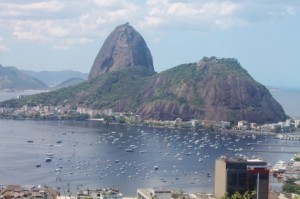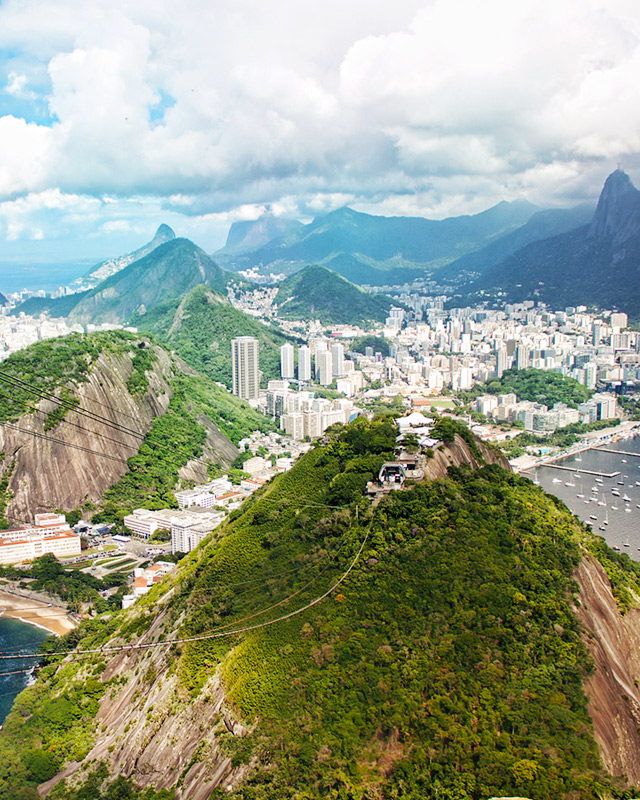
Photo © Michael Sommers.
At the top of any To Do list for first-time visitors to Rio de Janeiro are two obligatory ascents:
1. To the top of Corcovado (to take in jaw-dropping panoramic views of Sugarloaf and the city).
2. To the top of Sugarloaf (to take in jaw-dropping panoramic views of Corcovado and the city).
There’s no denying that the sweeping vistas gleaned from both privileged perches are worth every last centavo of the (lofty) prices of admission; R$44 for the train to the base of the Christ the Redeemer statue and R$53 for the cable car ride up to the summit of Sugarloaf. More daunting than the heights, or the prices, however, are the vast number of other first (and second, third, fourth)-time visitors to Rio intent on making the same obligatory ascents.
Although unknown to many tourists, there are happily many other Carioca summits that offer alternatively impressive views far from the multilingual madding crowds.It sucks some of the joy out of what, in theory, could be an experience verging on the sublime when you have to line up for hours to catch the trem for Corcovado (tip: wake up early in the morning to catch the first departure at 8:30 a.m.) and perform delicate maneuvers around throngs of topographical paparazzi, all jostling for the best spots from which to capture the chiseled features of famed geographical landmarks such as Dois Irmãos, Pedra da Gávea, and Copacabana beach.
Although unknown to many tourists, there are happily many other Carioca summits that offer alternatively impressive views far from the multilingual madding crowds. Access to these hilltop vantage points is easy – and free. Because these morros (“morro” is Portuguese for a large hill) are occupied by military bases and special UPP or Unidades de Polícia Pacificadora (Pacification Police Units installed in favelas to keep violence and drug traffickers at bay), safety is assured.

Sugarloaf Mountain in Rio de Janeiro. Photo © She Paused 4 Thought, licensed Creative Commons Attribution.
The big rock that juts out at the end of Leme beach (an extension of Copacabana’s white-fringed crescent) is known as Pedra do Leme. At its base is a military complex, which you pass through before embarking on a 20-minute hike along a cobblestoned trail that winds through patches of native Atlantic forest up to the summit of Morro do Leme. The hill is crowned by the Forte Duque de Caxias, a whitewashed fort built in 1779. From its sprawling rooftop festooned with cannons, Copacabana beach stretches out its languorous curves seductively while the backside of Sugarloaf is so close you can lick it.
Rising up from Botafogo, the Morro Dona Marta shelters the favela of Santa Marta, which has been occupied by UPP since December 2008. As part of the city’s program to integrate favelas into the fabric of the city and provide basic services for its residents, an elevator was installed to ferry residents – and tourists – up and down the steep hill. From the lookout point at the top, you’re close enough to Corcovado to reach out and tickle Christ the Redeemer’s exposed arm pits. At your feet, Sugarloaf is near enough to step on (see accompanying photo). A 5-minute walk through the favela’s narrow alleyways brings you to a square where a mosaic fresco and bronze statue both pay homage to Michael Jackson who shot the Spike Lee-directed video for his song “They Don’t Care About Us” in the community.
Straddling the Zona Sul beach neighborhoods of Copacabana and Ipanema, Morro do Cantagalo is covered by what were once two of Rio’s most infamous favelas, Cantagalo and Pavão/Pavãozinho, which between them are home to 10,000 people. In 2009, both favelas received UPP units and a year later, a brand new elevator was inaugurated that sweeps passengers up from the tony Ipanema street of Rua Teixeira de Melo (just behind the General Osório/Ipanema Metrô station) to the top of the morro. Another two flights up from the elevator is the Mirante da Paz, a look-out that provides incredible 360-degree views of the open Atlantic, Zona Sul beaches, Lagoa Rodrigo de Freitas, and the twin peaks of Dois Irmãos.
Not far from Cantagalo (in fact, only a 15-minute walk from the Cantagalo Metrô station in Copacabana), along the shores of Lagoa Rodrigo de Freitas, lies the Parque da Catacumba, a preserved patch of native Atlantic forest, part of which was replanted following the 1970 removal of a favela of the same name. From the park’s entrance at Avenida Epitácio Pessoa 3000, a trail winds its way up the Morro da Catacumba (the reference to “catacumbas” (catacombs) alludes to the fact that the area was believed to be a sacred indigenous burial ground). It passes a zipline course and a series of striking sculptures wrought by Brazilian artists, before climbing through lush jungle. A steep 20-minute climb brings you to the top where you’re treated to a choice of two look-outs; one facing towards Ipanema, Leblon and the Atlantic and the other staring down at the Gávea racetrack and Jardim Botânico with Corcovado hovering behind.